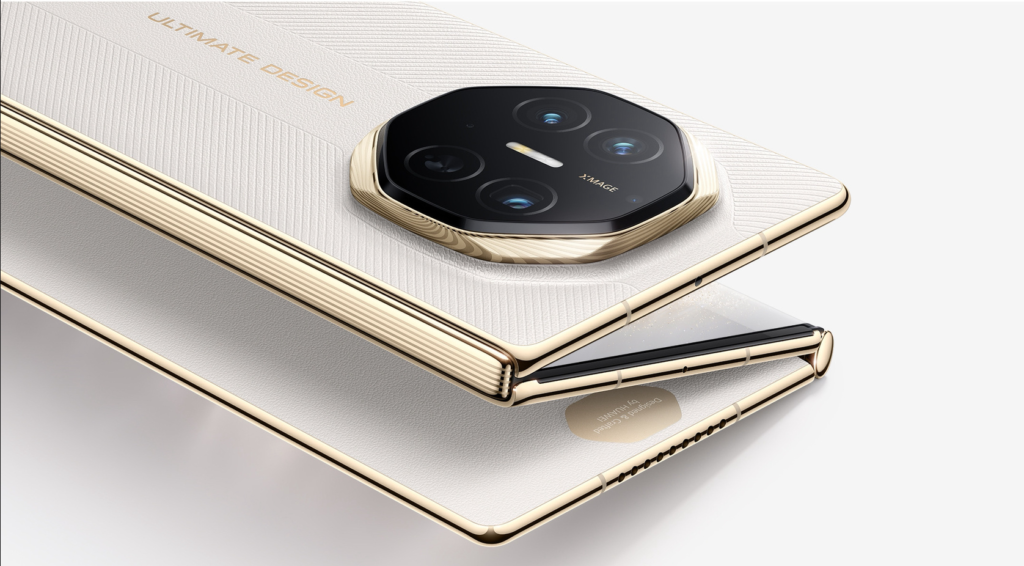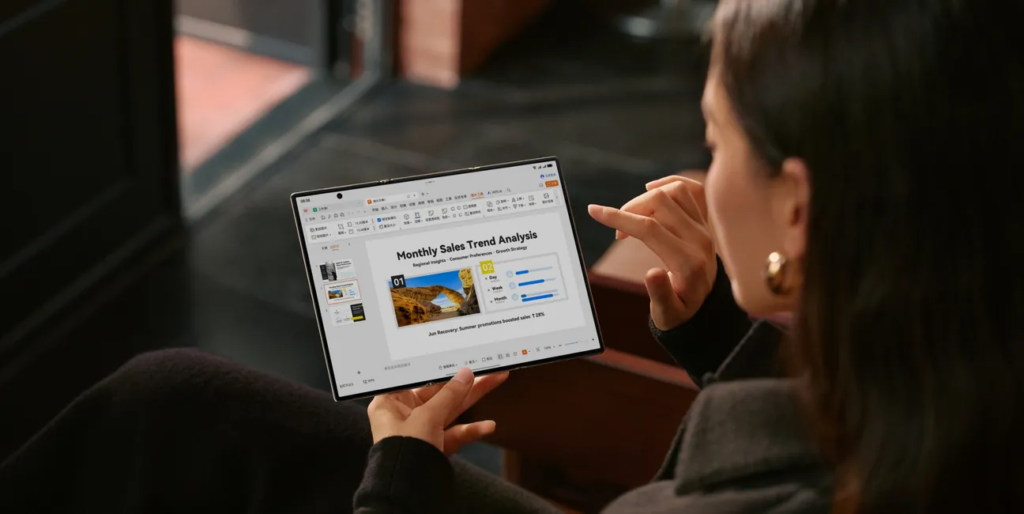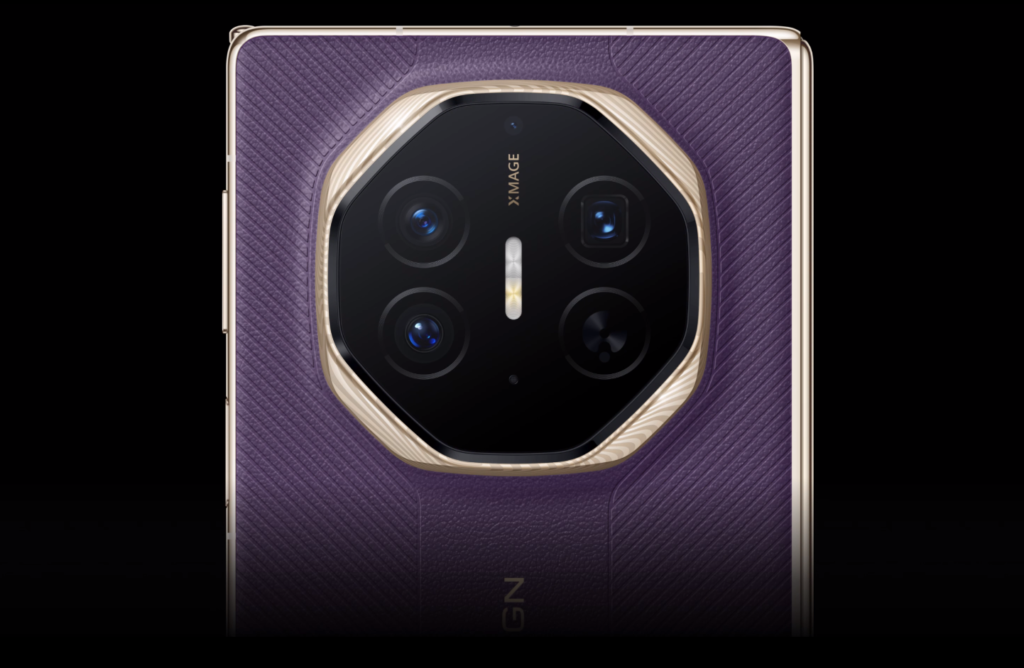
Huawei has launched the Mate XTs ULTIMATE DESIGN, the world’s second commercially available triple-folding smartphone, representing a paradigm shift in foldable phone technology. By prioritizing both groundbreaking form factor innovation and ecosystem integration, the Mate XTs ULTIMATE DESIGN redefines the standards for premium foldable devices and elevates the entire category.
The device retains the innovative “Z”-shaped triple-folding structure. When unfolded, it transforms into a stunning 10.2-inch display with a resolution of 2232×3184, boasting 1.07 billion colors, P3 wide color gamut support, and TÜV Rheinland All-Round Display Five-Star Certification. When folded, it becomes a highly portable 6.4-inch single-screen device with a remarkably slim 3.6mm profile (in triple-screen mode), offering a seamless blend of portability and immersive large-screen viewing. The display utilizes a robust composite structure combining non-Newtonian fluid and UTG glass, reinforced by the new “Tian Gong Hinge” system. This enhanced hinge design delivers a 23% increase in strength and a 35% improvement in screen impact resistance. The screen also supports a 1-90Hz LTPO adaptive refresh rate and 1440Hz high-frequency PWM dimming, ensuring both fluid performance and enhanced eye comfort.

Performance is driven by the groundbreaking Kirin 9020 chip. Leveraging comprehensive software-hardware-chip-cloud synergy and system-level optimizations through HarmonyOS 5, the Mate XTs ULTIMATE DESIGN achieves a 36% overall performance increase, delivering exceptional computing power for demanding tasks. A key innovation lies in the introduction of PC-grade multi-window interaction. In Free Multi-Window mode, application windows can be stacked, resized, and quickly switched. Panoramic Multi-Window mode supports three simultaneously active windows with adjustable sizes and cross-app content dragging, delivering PC-like multi-tasking efficiency. Paired with desktop-grade applications such as the PC version of WPS, Wind Financial Terminal, and East Money Information, users can seamlessly manage complex document processing, sophisticated stock analysis, and other professional workflows, truly enabling “mobile office desktopization.”

The imaging system receives a significant upgrade with a 40-megapixel RYYB ultra-wide-angle lens, boosting light intake by 40%. A new 1.5-million spectral channel Red Maple True Color Camera enhances color reproduction by 120%. The device also supports a 10-stop adjustable physical aperture, 5.5x optical zoom, and 100x digital zoom, meeting the needs of professional-grade photography and videography. For enhanced interaction, the new HUAWEI M-Pen 3 stylus provides a broad range of functionalities, including global annotations, split-screen excerpts, and quick note-taking. Switching to air mouse mode enables remote video navigation and presentation slide control. The deeply optimized HarmonyOS large-screen AI, featuring Xiaoyi Knowledge Base, personalized travel planning, in-depth problem-solving, and continuous translation, provides comprehensive assistance for learning, work, and travel.
Powering this advanced device is a 5600mAh silicon-anode battery, supporting 66W wired fast charging and 50W wireless fast charging, offering a 1-hour battery life extension compared to its predecessor. Advanced security features include large-screen privacy anti-peeping and secure file encryption sharing.
As a cornerstone of Huawei’s foldable phone ecosystem, the Mate XTs ULTIMATE DESIGN not only reinforces Huawei’s leadership in the foldable category but also propels the industry toward the “pocket PC” era, delivering a transformative mobile computing experience for users demanding unparalleled productivity.

ESD (Electrostatic Discharge) components are specialized electronic components designed to safeguard electronic devices from the damaging effects of electrostatic discharge. ESD is a sudden release of static electricity that can compromise the functionality or lifespan of sensitive electronic components. ESD components mitigate this risk by diverting, absorbing, or dissipating ESD events.
In mobile phones, ESD components are critical for protecting internal circuitry from ESD-induced damage. Due to the sensitivity of many components within a mobile phone, multiple ESD components are strategically placed to provide comprehensive protection. These components commonly include ESD diodes, TVS diodes, and other specialized protection devices.
Specifically, ESD components in mobile phones serve to protect various areas:
- Interface Protection: ESD protection is essential for interfaces such as charging ports, headphone jacks, and USB connectors to prevent damage from ESD events during connection.
- RF Circuit Protection: Radio Frequency (RF) circuits are highly susceptible to ESD and require dedicated ESD components to maintain signal integrity and prevent component failure.
- Processor and Memory Protection: Core components like processors and memory ICs require ESD protection to ensure reliable operation and data integrity.
- Touchscreen and Display Protection: Touchscreens and displays, integral to the user experience, are also vulnerable to ESD damage and are protected by dedicated ESD components.
In conclusion, ESD components are vital for protecting the internal electronics of mobile phones from ESD damage, ensuring their reliable operation, and extending their lifespan. Their strategic implementation is essential for maintaining device functionality and user satisfaction.